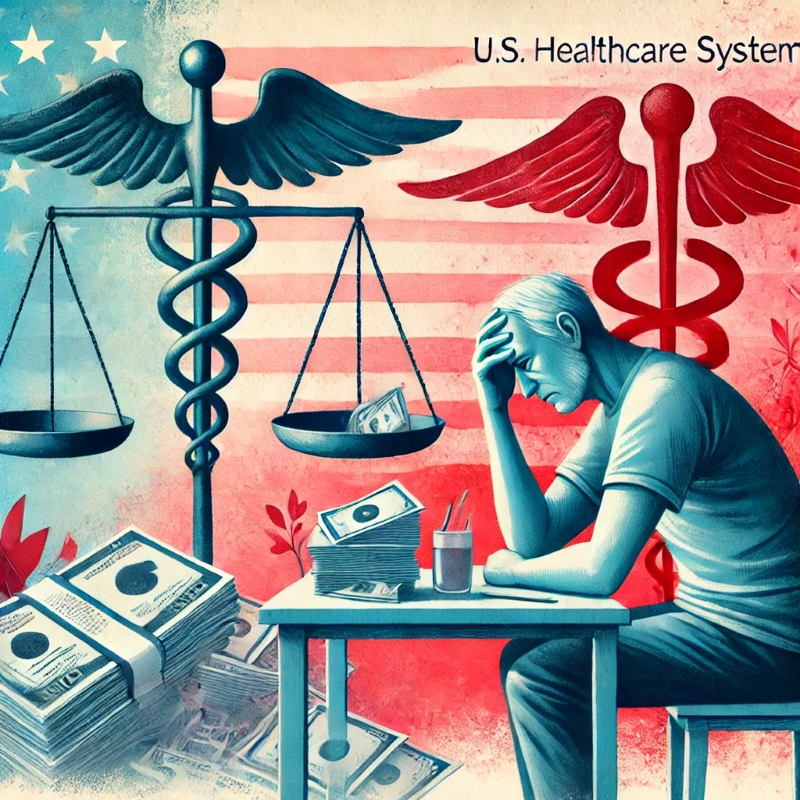Title: U.S. Healthcare: An Unaffordable Burden

The U.S. healthcare system has long been criticized for its inefficiencies and high costs. A recent report by the Commonwealth Fund has once again placed the United States at the bottom of a ranking of healthcare systems among the world’s 10 wealthiest nations. This result is not new; the U.S. has held this position for the past 20 years. Despite spending nearly twice as much on healthcare compared to other high-income countries and dedicating almost double the percentage of GDP to health expenditures, the U.S. remains the only nation in this group without universal healthcare coverage.
The Cost of Health Inequality
One of the main reasons for the U.S.’s poor performance is the widespread issue of healthcare affordability. Many Americans, even those with health insurance, find themselves struggling with medical debt. A staggering 100 million Americans, or 41% of adults, are currently trapped in medical debt. What’s even more alarming is that most of these individuals are employed and have health insurance. The problem lies in the design of their insurance plans, which are often inadequate due to high out-of-pocket costs. This situation has created a unique paradox where insured Americans still face financial ruin from medical expenses.
High Deductibles and “Functionally Uninsured”
The Commonwealth Fund’s report highlights a significant issue: the high-deductible health plans that many employers and insurers push onto workers. These plans come with unaffordable cost-sharing requirements, such as deductibles, copays, and coinsurance obligations. These financial barriers make it difficult for patients to seek medical care when needed, leading them to skip necessary medical tests, treatments, or follow-up visits. Some may even avoid filling prescriptions or skip doses of their medications.
For those who do seek care, the financial repercussions can be devastating. They often end up with substantial debt, a situation that Forbes magazine has described as being “functionally uninsured.” This means that despite having insurance, the high out-of-pocket costs render the coverage nearly useless in protecting against financial hardship.
The Unique Challenge of Medical Debt in the U.S.
Medical debt is a uniquely American problem. As the Commonwealth Fund’s report emphasizes, no other high-income nation faces this issue to such an extent. The reasons are multifaceted. Firstly, the U.S. is the only country in this group that allows for-profit insurance companies to dominate its healthcare system. These companies often prioritize profits over patient care, resulting in coverage that falls short of meeting people’s needs. Secondly, the lack of universal healthcare means that millions of Americans remain uninsured or underinsured, despite the improvements made under the Affordable Care Act (ACA).
Although the ACA expanded coverage to many previously uninsured Americans, it did not address the issue of underinsurance. Today, over 26 million people in the U.S. are still uninsured, while many more are struggling with the limitations of their high-deductible plans. These plans have deductibles that are not just high but sky-high, making it nearly impossible for many to afford the care they need.
Government Efforts to Alleviate Medical Debt
Recognizing the severity of the medical debt crisis, the Biden-Harris administration has made tackling this issue a priority. In the coming weeks, the White House is expected to announce measures aimed at alleviating the burden of medical debt on American families. One of the key proposals is to cap out-of-pocket prescription drug costs at $2,000 per year for all Americans, not just those on Medicare. This change is set to go into effect for Medicare recipients in January, but there is a push for Congress to extend this cap to everyone.
The Lower Out-of-Pockets NOW coalition has been advocating for such changes, calling on Congress to pass this legislation before the end of the year. The hope is that these measures will provide some relief to the millions of Americans who are currently overwhelmed by medical expenses.
The Path Forward: A Call for Systemic Change
The Commonwealth Fund’s report is a stark reminder of the urgent need for systemic change in the U.S. healthcare system. While the Biden-Harris administration’s efforts are a step in the right direction, much more needs to be done to ensure that all Americans have access to affordable healthcare. This includes not only addressing the issue of high out-of-pocket costs but also working towards a more equitable and efficient healthcare system that prioritizes patient well-being over profit.
For those who still believe that the U.S. has the best healthcare system in the world, the Commonwealth Fund’s findings should serve as a wake-up call. The reality is that many Americans are suffering, not because of a lack of medical advancements or expertise, but because of a system that puts financial barriers between people and the care they need.
If you would like to delve deeper into the U.S. healthcare system’s issues and explore potential solutions, stay tuned as we continue to unpack the findings of the Commonwealth Fund report in future posts.
SEO Keywords: U.S. healthcare system, medical debt, high-deductible plans, Commonwealth Fund report, healthcare affordability.
Disclaimer: AI-generated medical content is not a substitute for professional medical advice or diagnosis; I hope you found this blog post informative and interesting. www.parkiesunite.com by Parkie.
DALL-E Prompt: “A watercolor illustration depicting a person sitting at a table filled with medical bills, looking overwhelmed. In the background, an abstract representation of the U.S. healthcare system, showing a scale tipping towards debt and high costs. The image captures the emotional weight of medical debt in a stylized yet impactful manner.”